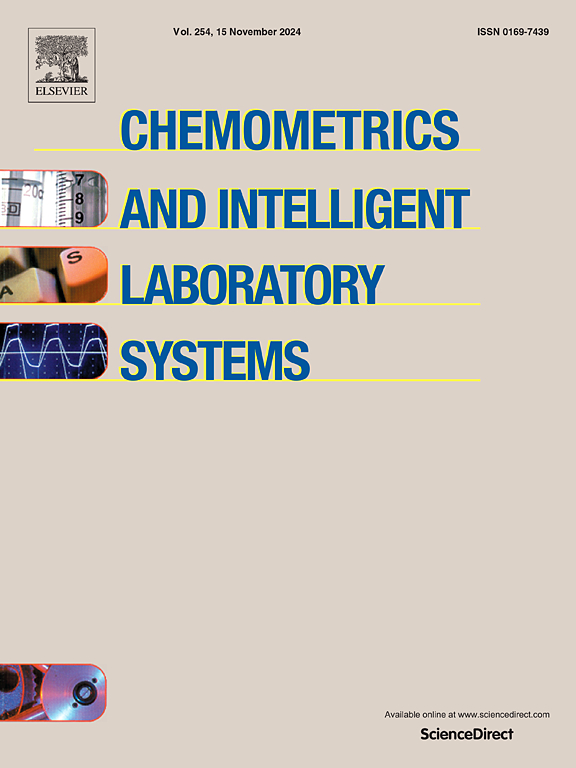灵芝中潜在抗肿瘤成分的预测:利用机器学习和分子对接的综合方法
IF 3.7
2区 化学
Q2 AUTOMATION & CONTROL SYSTEMS
Chemometrics and Intelligent Laboratory Systems
Pub Date : 2024-11-08
DOI:10.1016/j.chemolab.2024.105271
引用次数: 0
摘要
本研究的目的是开发一种可靠的抗肿瘤活性预测模型,并确定灵芝中潜在的抗肿瘤成分。利用摩根指纹作为分子描述符,采用包括随机森林在内的四种机器学习模型来训练抗肿瘤活性预测模型。然后利用最有效的模型预测灵芝的化学成分,确定了四种最有可能与已知 TNF-α 相关靶点进行分子对接的化合物。研究结果表明,支持向量机(SVM)模型的准确度、F1得分、AUC和灵敏度分别为0.7638、0.7638、0.8332和0.7621。该模型在预测美国 FDA 批准的 10 种药物的抗肿瘤活性方面显示出 80% 的准确率。此外,该模型还发现灵芝中包括3-硝基苯甲醚在内的11种成分的抗肿瘤活性概率超过0.5,表明它们具有作为抗肿瘤药物的潜力。分子对接程序的结果表明,从灵芝中提取的四种最有潜力的抗肿瘤化合物与 TNF-α 靶点具有良好的结合亲和力。总之,本研究在分子对接之前加入了机器学习预测步骤,从而提高了后者的可靠性。此外,它还发现了灵芝中以前未报道过的具有潜在抗肿瘤活性的化合物,如3-硝基苯甲醚。本文章由计算机程序翻译,如有差异,请以英文原文为准。
Prediction of potential antitumor components in Ganoderma lucidum: A combined approach using machine learning and molecular docking
The objective of this study is to develop a reliable predictive model for antitumour activity and to identify potential antitumour components in Ganoderma lucidum. Four machine learning models, including Random Forest, were employed to train predictive models for antitumour activity, utilising Morgan fingerprints as molecular descriptors. The most effective model was then employed to predict the chemical composition of Ganoderma lucidum, identifying the four most probable compounds for molecular docking with known TNF-α-related targets. The findings of the study indicate that a Support Vector Machine (SVM) model exhibits an accuracy, F1 score, AUC, and sensitivity of 0.7638, 0.7638, 0.8332, and 0.7621, respectively. The model demonstrated an 80 % accuracy rate in predicting the antitumour activity of 10 FDA-approved drugs. Besides, the model identified 11 components in Ganoderma lucidum, including 3-nitroanisole, with a probability of antitumour activity exceeding 0.5, indicating their potential as antitumour agents. The results of the molecular docking procedure indicated that the four most promising antitumour compounds derived from Ganoderma lucidum exhibited a favourable binding affinity with the TNF-α target. In conclusion, this study incorporated a machine learning prediction step prior to molecular docking, thereby enhancing the reliability of the latter. Furthermore, it identified previously unreported compounds in Ganoderma lucidum with potential antitumour activity, such as 3-nitroanisole.
求助全文
通过发布文献求助,成功后即可免费获取论文全文。
去求助
来源期刊
CiteScore
7.50
自引率
7.70%
发文量
169
审稿时长
3.4 months
期刊介绍:
Chemometrics and Intelligent Laboratory Systems publishes original research papers, short communications, reviews, tutorials and Original Software Publications reporting on development of novel statistical, mathematical, or computer techniques in Chemistry and related disciplines.
Chemometrics is the chemical discipline that uses mathematical and statistical methods to design or select optimal procedures and experiments, and to provide maximum chemical information by analysing chemical data.
The journal deals with the following topics:
1) Development of new statistical, mathematical and chemometrical methods for Chemistry and related fields (Environmental Chemistry, Biochemistry, Toxicology, System Biology, -Omics, etc.)
2) Novel applications of chemometrics to all branches of Chemistry and related fields (typical domains of interest are: process data analysis, experimental design, data mining, signal processing, supervised modelling, decision making, robust statistics, mixture analysis, multivariate calibration etc.) Routine applications of established chemometrical techniques will not be considered.
3) Development of new software that provides novel tools or truly advances the use of chemometrical methods.
4) Well characterized data sets to test performance for the new methods and software.
The journal complies with International Committee of Medical Journal Editors'' Uniform requirements for manuscripts.

 求助内容:
求助内容: 应助结果提醒方式:
应助结果提醒方式:


